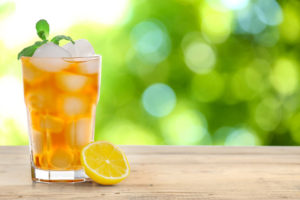Cold Brew Tea: Healthy Benefit and How To

Glass of cold brewed tea, iced.
When we first wrote the article in 2017, very few people heard about “cold brewing”. Fast forward to 2021, it seems like every coffee shop is offering some “cold brew” coffee. Cold brewing is nothing new. It has been around for decades. While we knew cold brewing results in a delicious cup of tea that is less bitter and astringent, the science behind cold brew tea was not out until recent years.
Tea is good for you. That is a fact. Why? Because tea contains polyphenolic compounds: catechins, epicatechins, theaflavins, flavonol glycosides, L-theanine, caffeine, and theobromine. These bioactive components are responsible for the astringency, flavor, aroma, and taste of the tea as well as its health beneficial effects.
Recent published scientific studies have shown that cold brewing tea gives you more bioactive components than using the traditional hot brewing method, particularly the catechins, epicatechins, theaflavins…the good stuff you want. Cold brewing releases more polyphenolic compounds while minimize the release of caffeine. For a list of articles related to these researches, scroll to the bottom. They are a long but worthy read.
Cold Brewed Tea –So So Easy.
ICED TEA is a summer staple, but when it’s over 100 °F out, the thought of boiling a pot of hot water just seems a bit unbearable. Fret not! We got a solution for you. Two words: Cold Brew!
Follow the below steps to some seriously delicious cold brew tea, and we promise, you will wonder why you hadn’t tried cold brewing earlier!
You will need:
- A large bottle or pitcher. We like to use the old fashion Mason Jars. You will need the real large ones.
- Good drinking water. If your tap water is drinkable, then use tap water.
- Tea types? All teas can be cold brewed. Even though the healthful benefits are more or less the same, the taste and flavor will differ. Our suggestion, start with your favorite type of tea and start your own experiment. Alishan Oolong is our absolute favorite.
- Flower teas or herbal ? Certain herbal will work nicely, though stay away from anything containing any types of dried rind. They will give your cold brew an unpleasant after taste.
How To:
Drop tea leaves into your bottle or pitcher, add water and fill to top, let it steep for 6 – 8 hours in normal room temperature. That’s it. Strain, add ice, and enjoy. After tea is brewed, store it in the fridge. Tea is good for a few days in the fridge.
We Prefer this method:
Drop tea leaves into your pitcher, add cold water and fill to top. Leave in the fridge for at least 12 hours. 24 hours is fine too, but not longer than that. Strain and enjoy. Store tea in the fridge and use it up within a few days.
How Much Tea and water to use?
You will need about 3g of teas (that’s about a heaping teaspoon) per 500ml water. If your tea is a good quality tea, You should get 2 brews out of your tea.
What type of tea to use for cold brew?
Any tea will work. Our suggestions: Start experimenting with cheaper teas. For black tea, Lipton and Tetley will brew to a nice sweet black tea. Of course, you can use our Taiwan Jin Xuan Black too. Honey Red Jade brews nicely too.
Characteristic of Cold Brew Tea
You will first notice a crystal clear tea. The tea will have a jewel like transparent melon yellow or warm amber color, depending on the type of tea you use. Next, you will notice the amazing flavor. Cold brewed tea is dramatically different from regular hot tea or “iced” tea. The cold brewed tea is sweet. Much sweeter than you would expect, with no hint of bitter. When cold brewing, both the tannins and caffeine are released at a much lower amount in comparison to when tea leaves are brewed with hot water. While cold brewed tea still contain caffeine, it is much less than hot tea or iced tea, thus making it easier to drink and easy on the stomach. Cold brewed tea also has much less tannins, which makes it much less astringent, so you would notice the sweetness on the first sip.
Try to stay away from adding fresh fruit to your tea while it is brewing. If you want to infuse your tea with fruits, we suggest to use freezed dried fruits. You will be amazed with the results.
Can you put the “cold brew” tea in the fridge?
Sure, but be sure to first give it at least 3 hours of steeping time at room temperature. This way, you will experience maximum flavor. IF not, then be prepared to leave the tea brewing in fridge for 12-24 hours.
What is the difference between a cold brewed tea vs a “sun” brewed tea?
Another popular way to brew tea is to let the tea bags soak in water, and leave the pitcher out in the sun for a few hours, and then add ice. The sun brewed tea is another variation of the classically brewed iced tea. The biggest difference is taste. Sun brewed iced tea is nowhere as sweet as a cold brew. When room temperature water is used to brew tea, there is very little heat to release the tannins and caffeine in the tea, resulting in a smooth sweet tasting tea.
List of Articles
Elisabetta Damiani, Tiziana Bacchetti, Lucia Padella, Luca Tiano, Patricia Carloni,
Antioxidant activity of different white teas: Comparison of hot and cold tea infusions,
Journal of Food Composition and Analysis,Volume 33, Issue 1, 2014,
Pages 59-66, ISSN 0889-1575, https://doi.org/10.1016/j.jfca.2013.09.010.
Elisabetta Venditti, Tiziana Bacchetti, Luca Tiano, Patricia Carloni, Lucedio Greci, Elisabetta Damiani,
Hot vs. cold water steeping of different teas: Do they affect antioxidant activity?,
Food Chemistry, Volume 119, Issue 4, 2010,Pages 1597-1604,ISSN 0308-8146,
https://doi.org/10.1016/j.foodchem.2009.09.049.
Sheng-Dun Lin, En-Hui Liu, Jeng-Leun Mau,
Effect of different brewing methods on antioxidant properties of steaming green tea,
LWT – Food Science and Technology,Volume 41, Issue 9,2008,Pages 1616-1623,ISSN 0023-6438,
https://doi.org/10.1016/j.lwt.2007.10.009.


